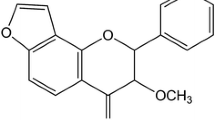Abstract
Objective
To investigate the anti-proliferative effects of saponins prepared from Plena Clematis (PC) cultured in Fujian Province, China on 4 human tumor cell lines and its possible anti-tumor mechanism.
Methods
The growth inhibition assays of saponins on human esophageal squamous carcinoma cell line (EC9706), human hepatoma cell line (HepG-2), human oral cancer cell line (KB) and human gastric cancer cell line (BGC-823) were evaluated in vitro by thiazolyl blue (MTT) method. The inhibitory effects on EC9706 treated with different concentrations of saponins (15.62, 31.25, 62.50, 125, 250 and 500 μg/mL) were performed in vitro by MTT method. The morphology and nuclear staining with acridine orange/ethidium bromide of EC9706 cells treated with saponins were illustrated under an inverted phase fluorescence microscope. The apoptotic effects of saponins were further evaluated by annexin-V/propidium iodide dual staining experiment to examine the occurrence of phosphatidylserine externalization onto the cell surface by a flflow cytometer.
Results
MTT assay showed that the saponins could inhibit the proliferation of 4 tumor cell lines. Among them, the maximum inhibition rate of 73.1% was detected in EC9706 cells at the saponins concentration of 250 μg/mL for 24 h. Further investigation indicated that the saponins induced EC9706 cells apoposis. The EC9706 cells presented apoptotic characteristics when treated with saponins, including that the morphologies of EC9706 cells were appeared round-shaped with higher refraction, and the cell nuclear stained orange with EB after 250 μg/mL saponins exposure. The flow cytometry analysis results showed that the induction of cell cycle arrest in apoptotic system may participate in the anti-proliferative activity of saponins on EC9706 cells.
Conclusion
The saponins from PC exhibited significant cytotoxicity against human EC9706, KB, BGC-823, and HepG-2 cells and might be beneficial to development of ethnic pharmaceutical plant for potential anti-tumor drugs.
Similar content being viewed by others
References
Wang WT, Li LQ. A new system of classification of the genus Clematis (Ranunculaceae). Acta Phytotax Sin 2005;43:431–488.
Jiang N, Guan KY, Wang ZL. Species diversity and geographical distribution of Clematis (Ranunculaceae) in Yunnan. Acta Bot Yunnanica 2007;29:145–154.
He YX, Li L, Zhang K, Liu ZR. Cytotoxic triterpene saponins from Clematis mandshurica. J Asian Nat Prod Res 2011;13:1104–1109.
Zhao M, Tang HF, Qiu F, Tian XR, Ding Y, Wang XY, et al. Triterpenoid saponins from Clematis argentilucida. Biochem Systemat Ecol 2012;40:49–52.
Liu LF, Ma XL, Wang YX, Li FW, Li YM, Wan ZQ, et al. Triterpenoid saponins from the roots of Clematis chinensis Osbeck. J Asian Nat Prod Res 2009;11:389–396.
Fu Q, Zan K, Zhao MB, Zhou SX, Shi SP, Jiang Y, et al. Three new triterpene saponins from Clematis chinensis. J Asian Nat Prod Res 2013;15:610–618.
Li SG, Huang XJ, Li MM, Wang M, Feng RB, Zhang W, et al. Triterpenoid saponins from the roots of Clematis uncinata. Chem Pharm Bull 2014;62:35–44.
Mostafa M, Appidi JR, Yakubu MT, Afolayan AJ. Anti-inflammatory, antinociceptive and antipyretic properties of the aqueous extract of Clematis brachiata leaf in male rats. Pharm Biol 2010;48:682–689.
Rattan R, Reddy SG, Dolma SK, Fozdar BI, Gautam V, Sharma R, et al. Triterpenoid saponins from Clematis graveolens and evaluation of their insecticidal activities. Nat Prod Commun 2015;10:1525–1528.
Ding Q, Yang LX, Yang HW, Jiang C, Wang YF, Wang S. Cytotoxic and antibacterial triterpenoids derivatives from Clematis ganpiniana. J Ethnopharmacol 2009;126:382–385.
Gong YX, Hua HM, Xu YN, Liu JY, Yu ZG, Ma J, et al. Triterpene saponins from Clematis mandshurica and their antiproliferative activity. Planta Med 2013;79:987–994.
Lin L, Zhu FR. Studies on the chemical constituents of crude extracts from Clematis florida Thunb. var. plena D. Don. J Front Med (Chin) 2014;27:34–36.
Tian XR, Feng JT, Tang HF, Zhao M, Li Y, Hai WL, et al. New cytotoxic triterpenoid saponins from the whole plant of Clematis lasiandra Maxim. Fitoterapia 2013;90:233–239.
Zhao M, Ma N, Qiu F, Tian XR, Zhang Y, Tang HF, et al. Triterpenoid saponins from the roots of Clematis argentilucida. Fitoterapia 2014;97:234–240.
Author information
Authors and Affiliations
Corresponding author
Additional information
Supported by the Medical Elite Cultivation Program of Fujian Province, China (No. 2016-ZQN-75) and the Medical Innovation Subject of Fujian Province, China (No. 2012-CX-5)
Rights and permissions
About this article
Cite this article
Zhu, Fr., Li, Yn., He, Sl. et al. Cytotoxic Activities of Total Saponins from Plena Clematis on Human Tumor Cell Lines In Vitro. Chin. J. Integr. Med. 24, 763–767 (2018). https://doi.org/10.1007/s11655-018-2839-z
Accepted:
Published:
Issue Date:
DOI: https://doi.org/10.1007/s11655-018-2839-z




